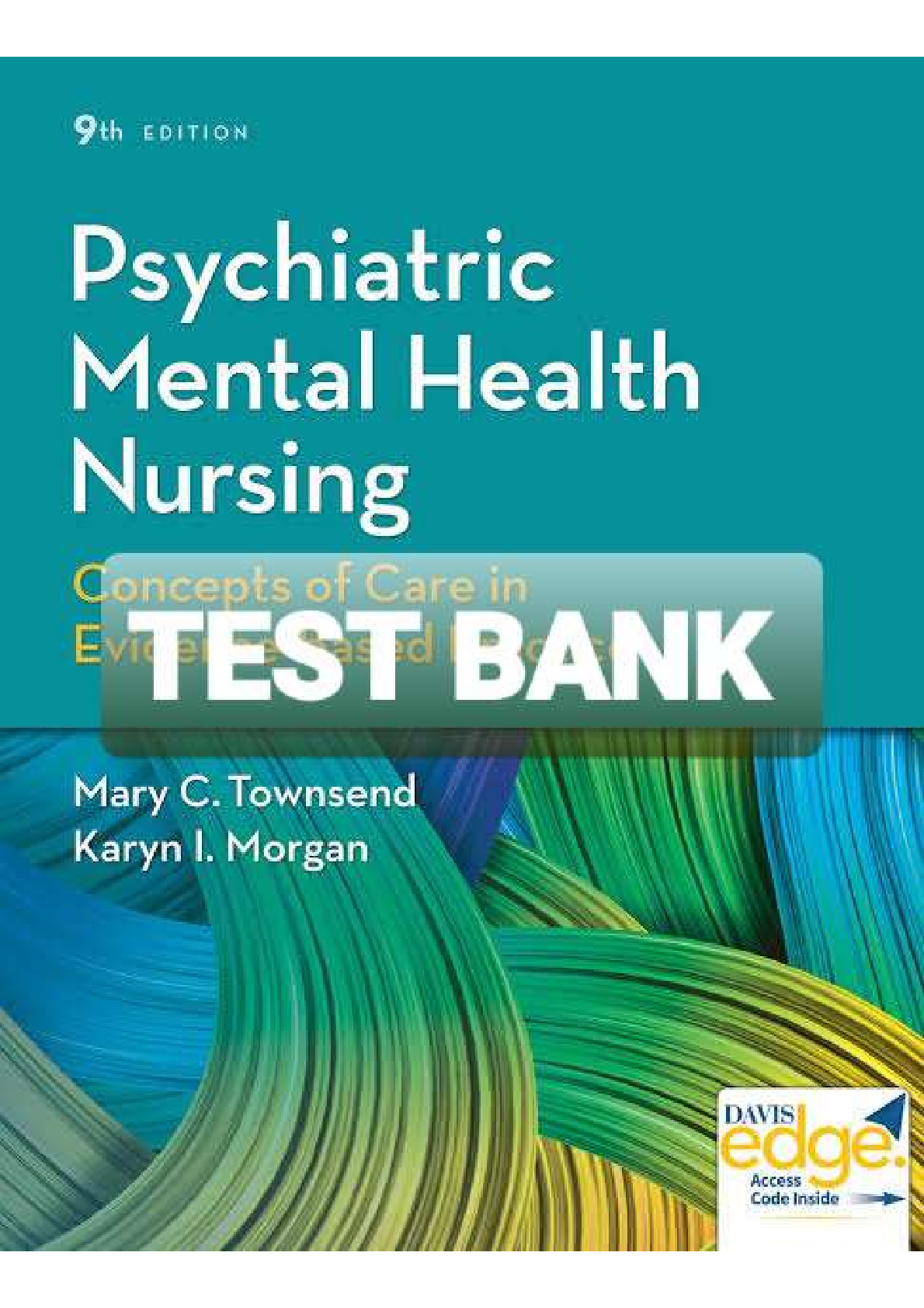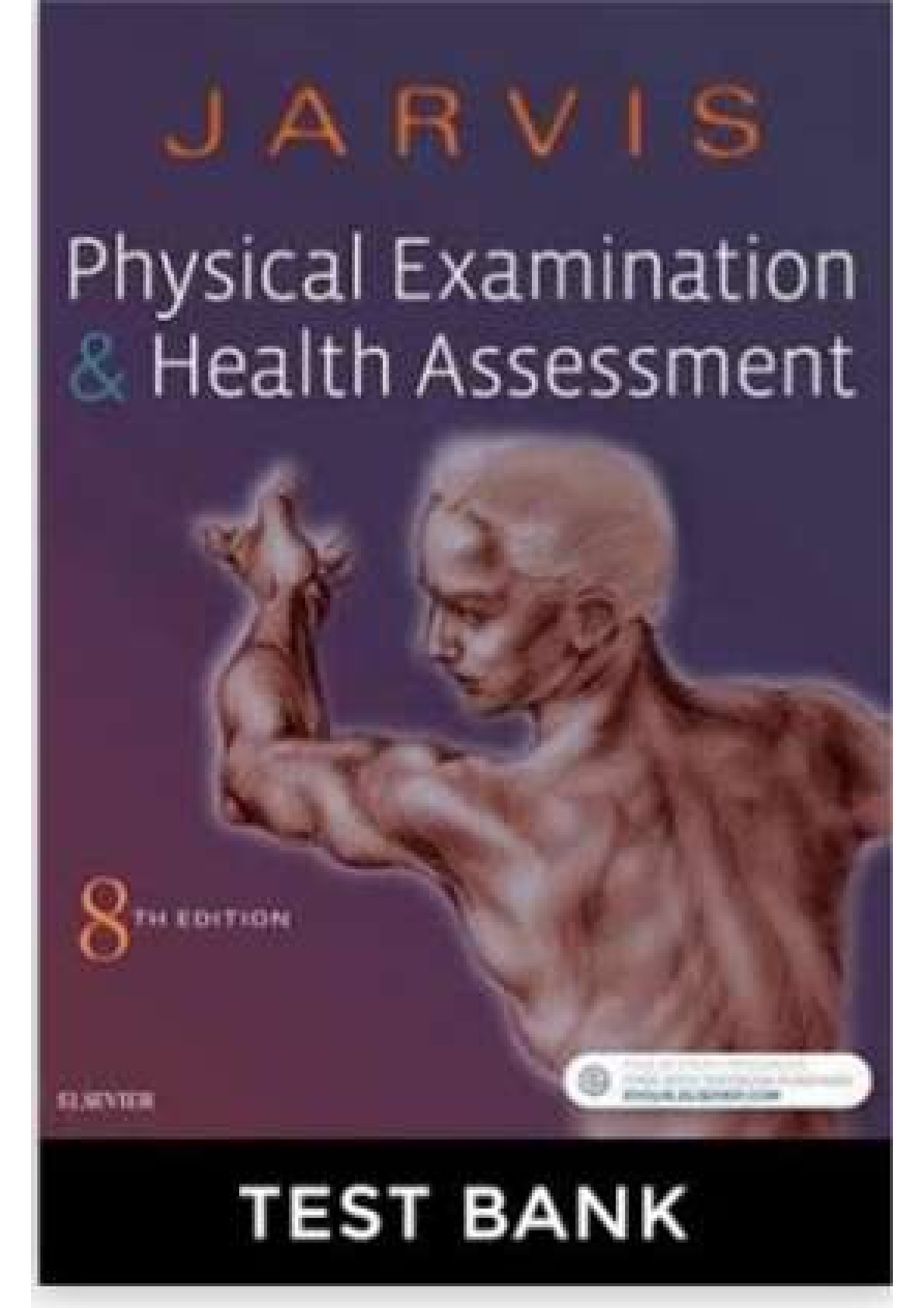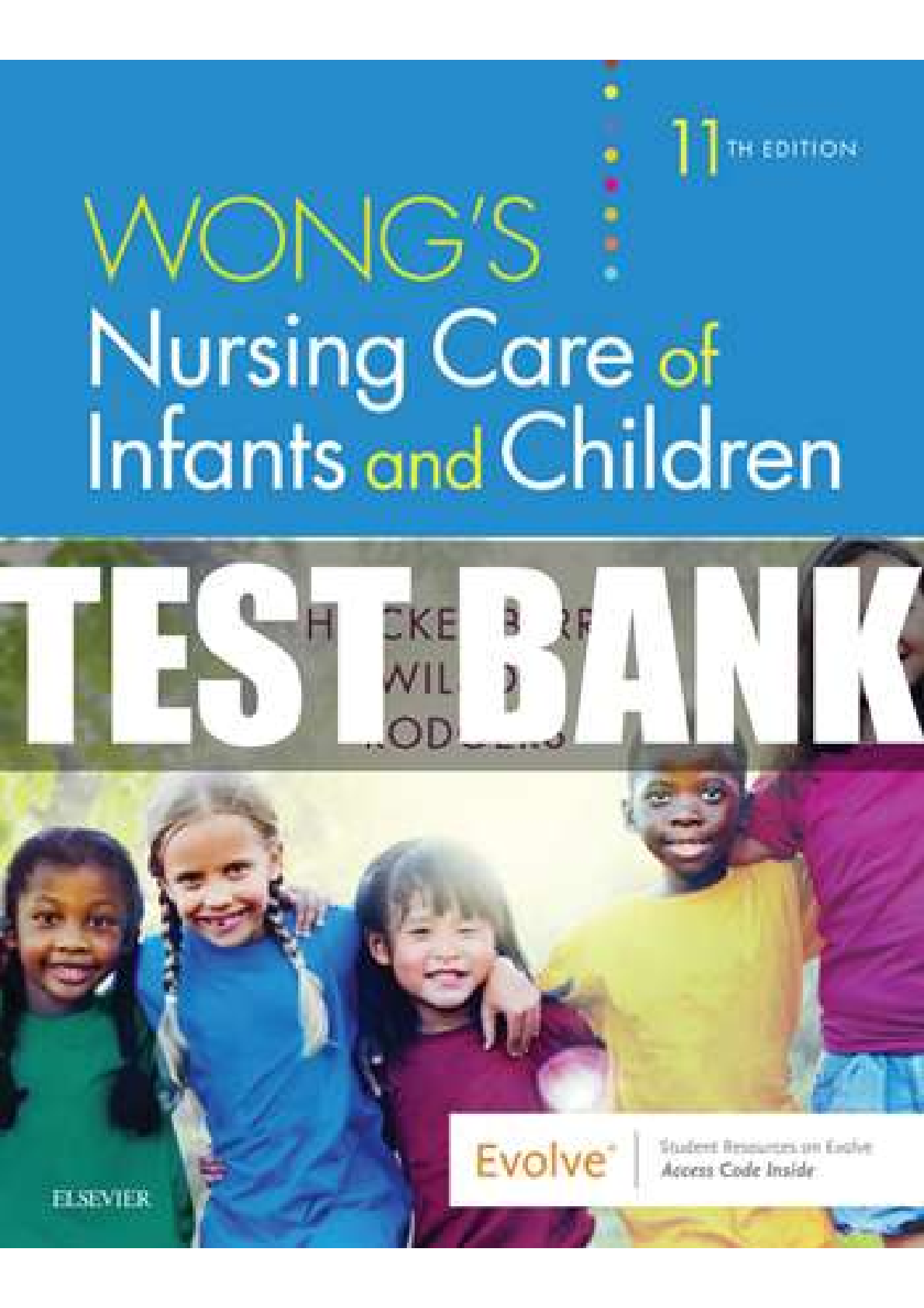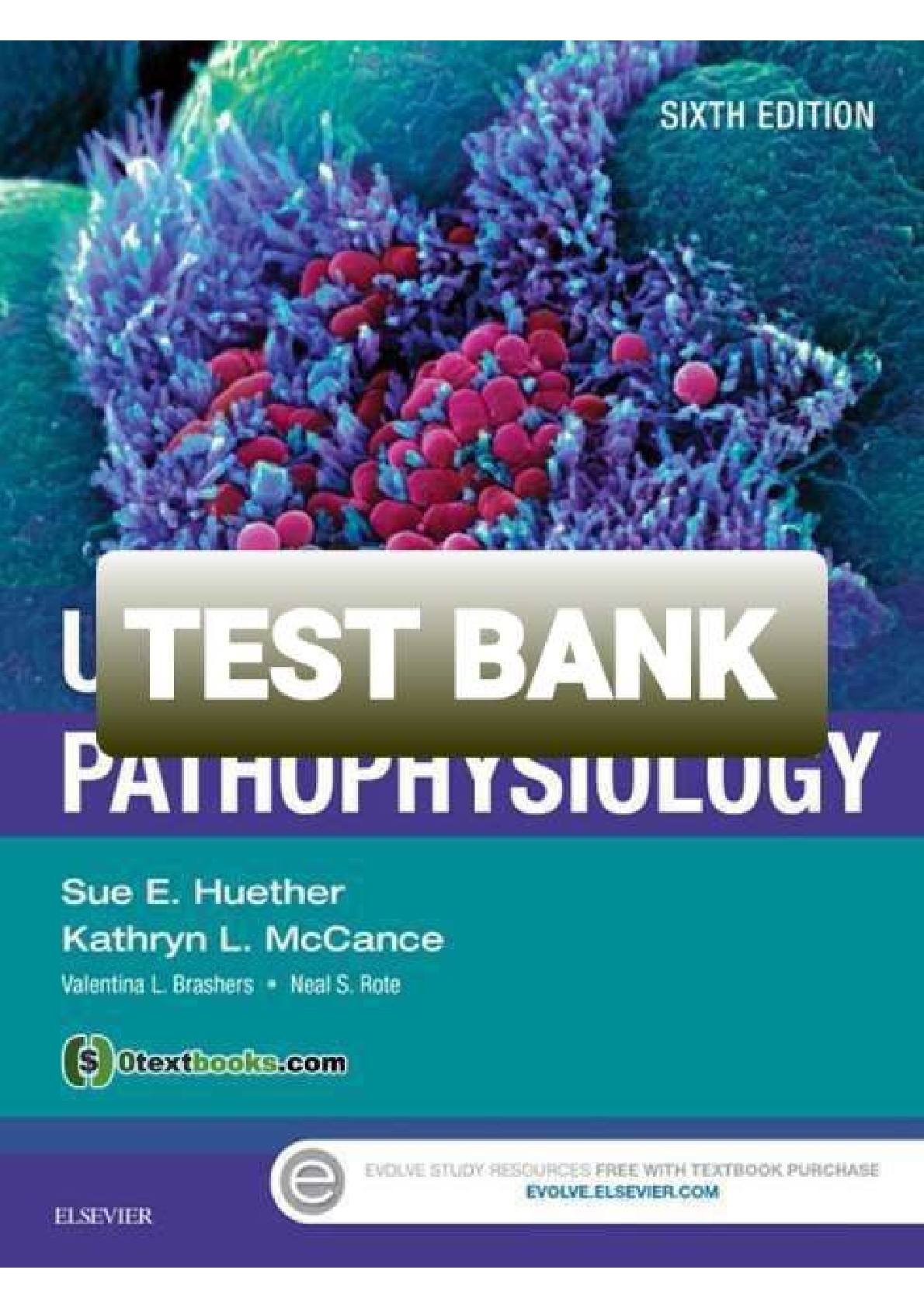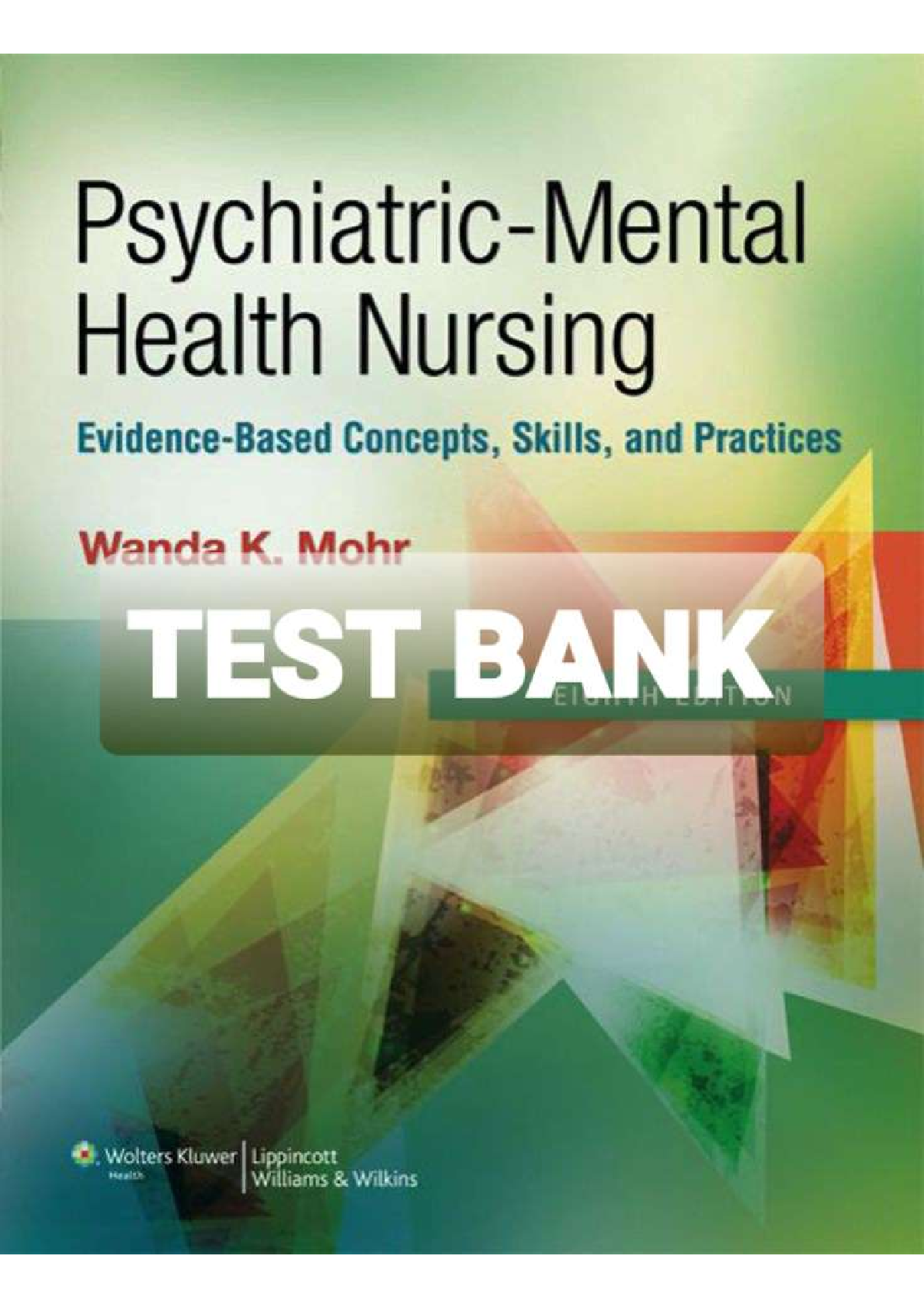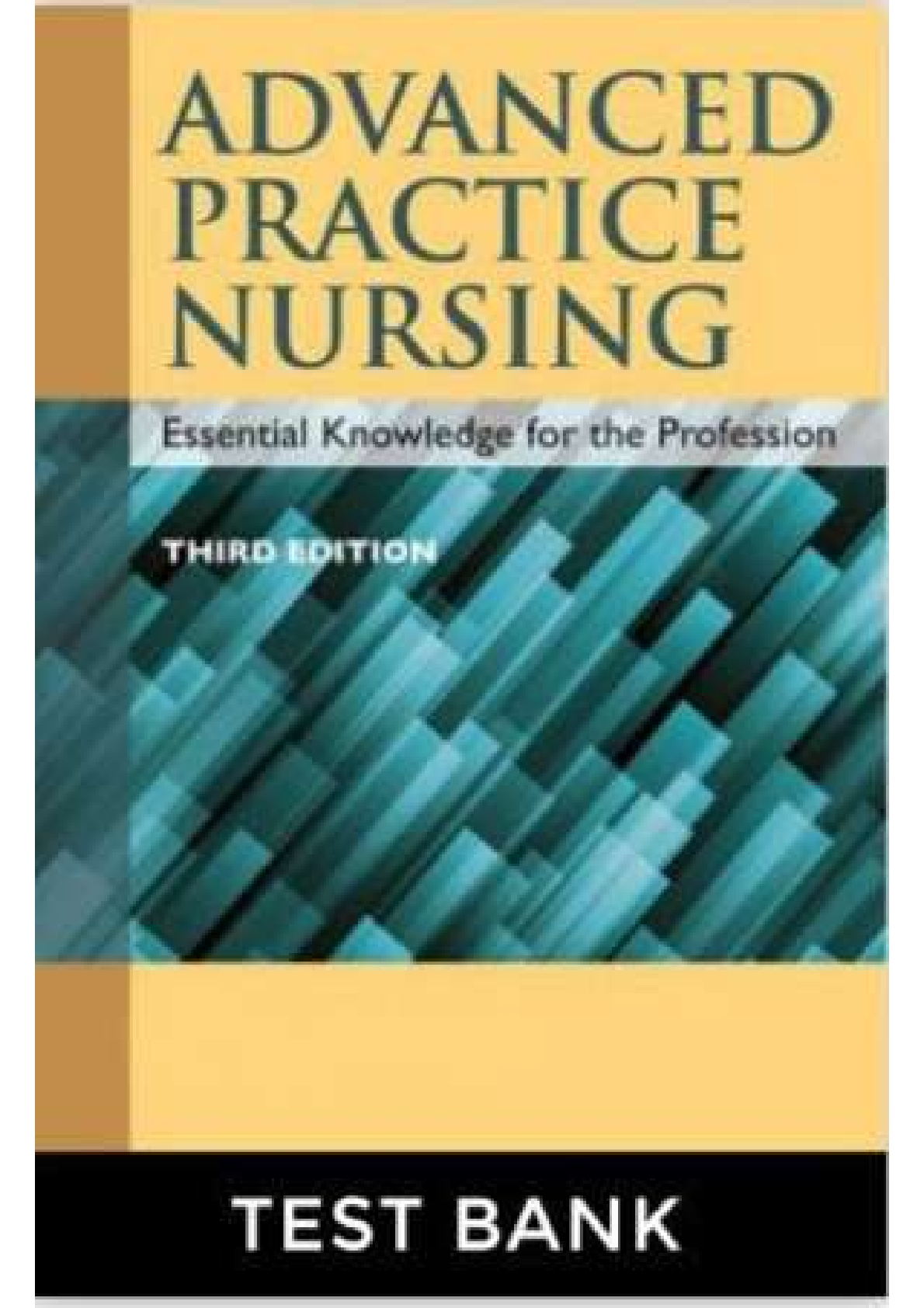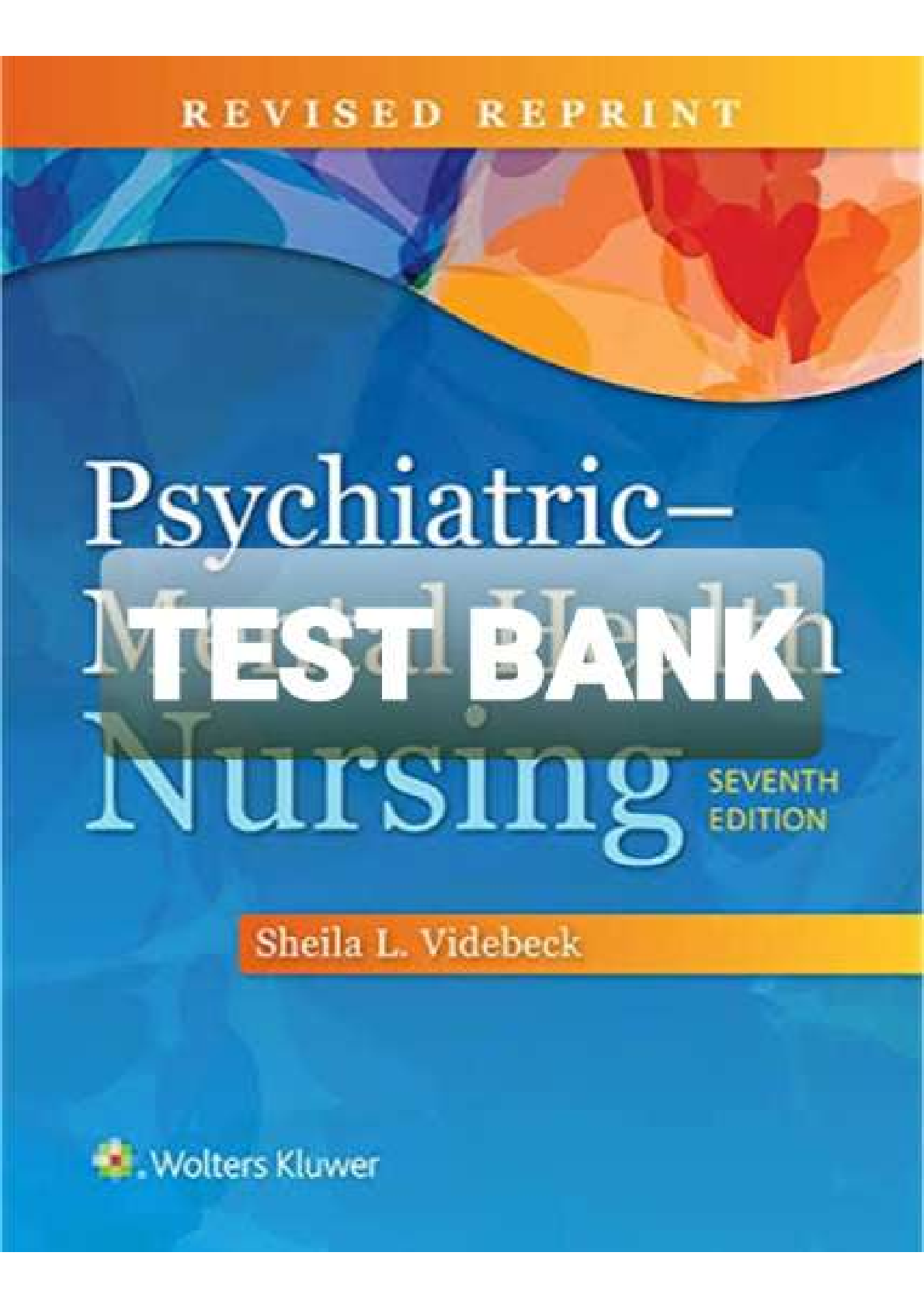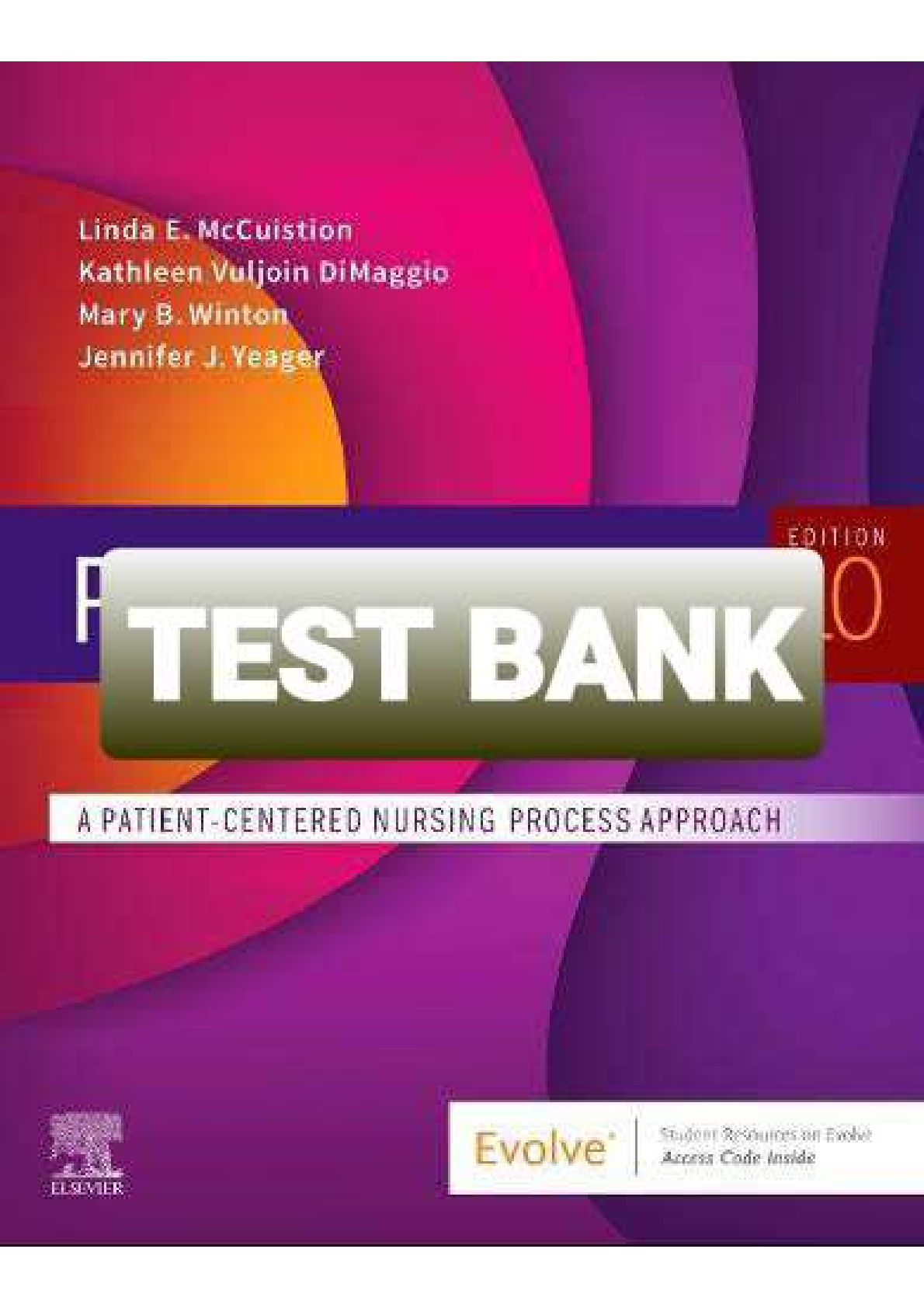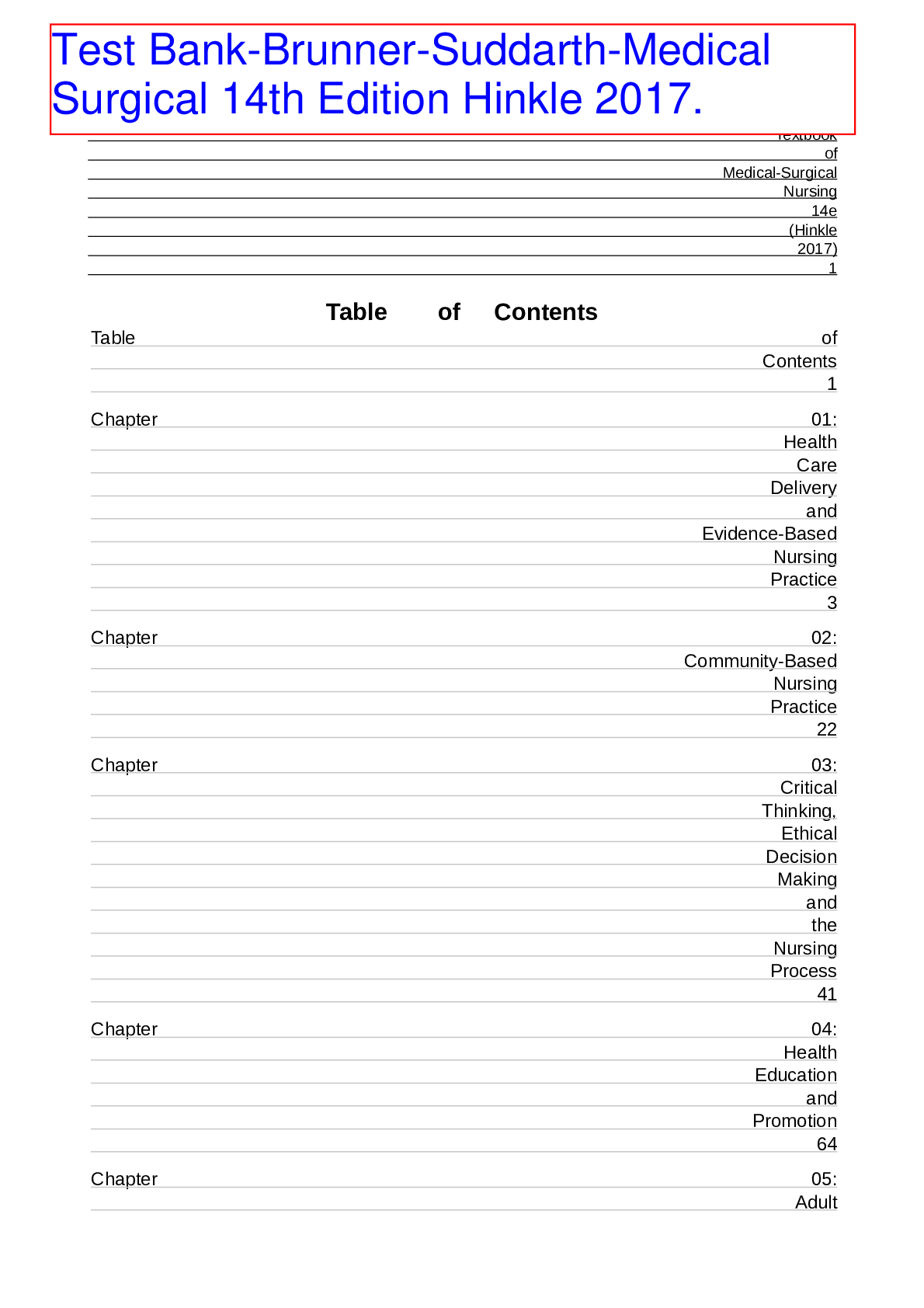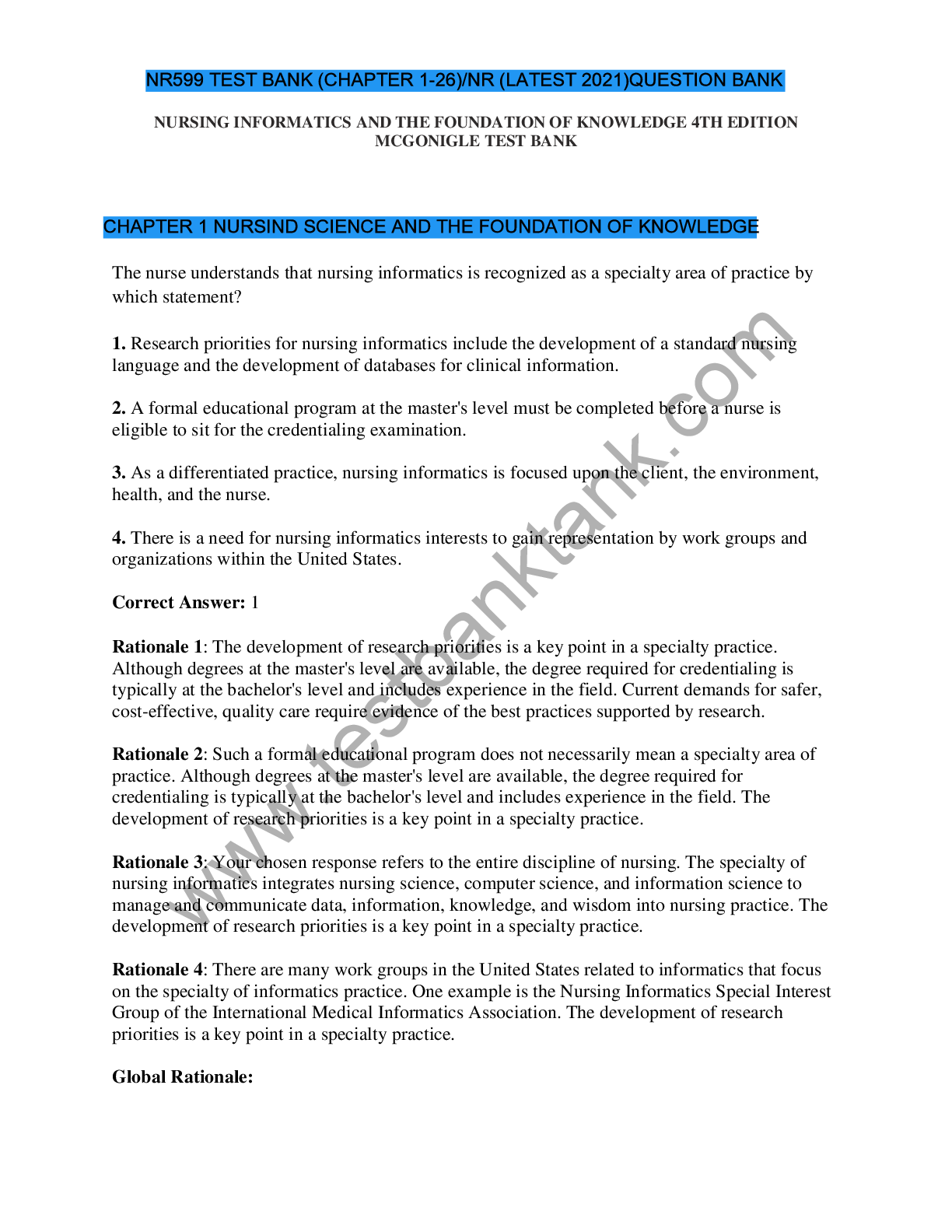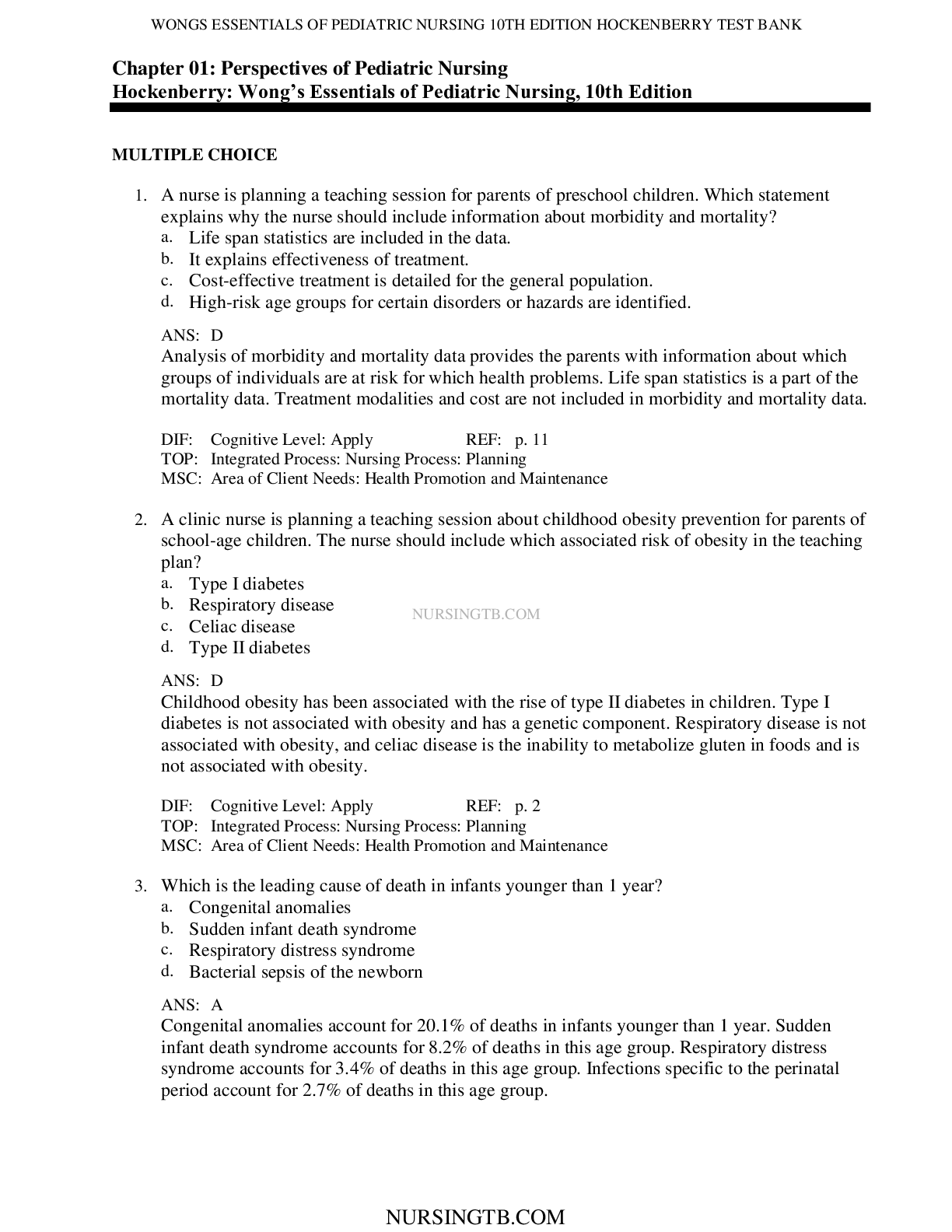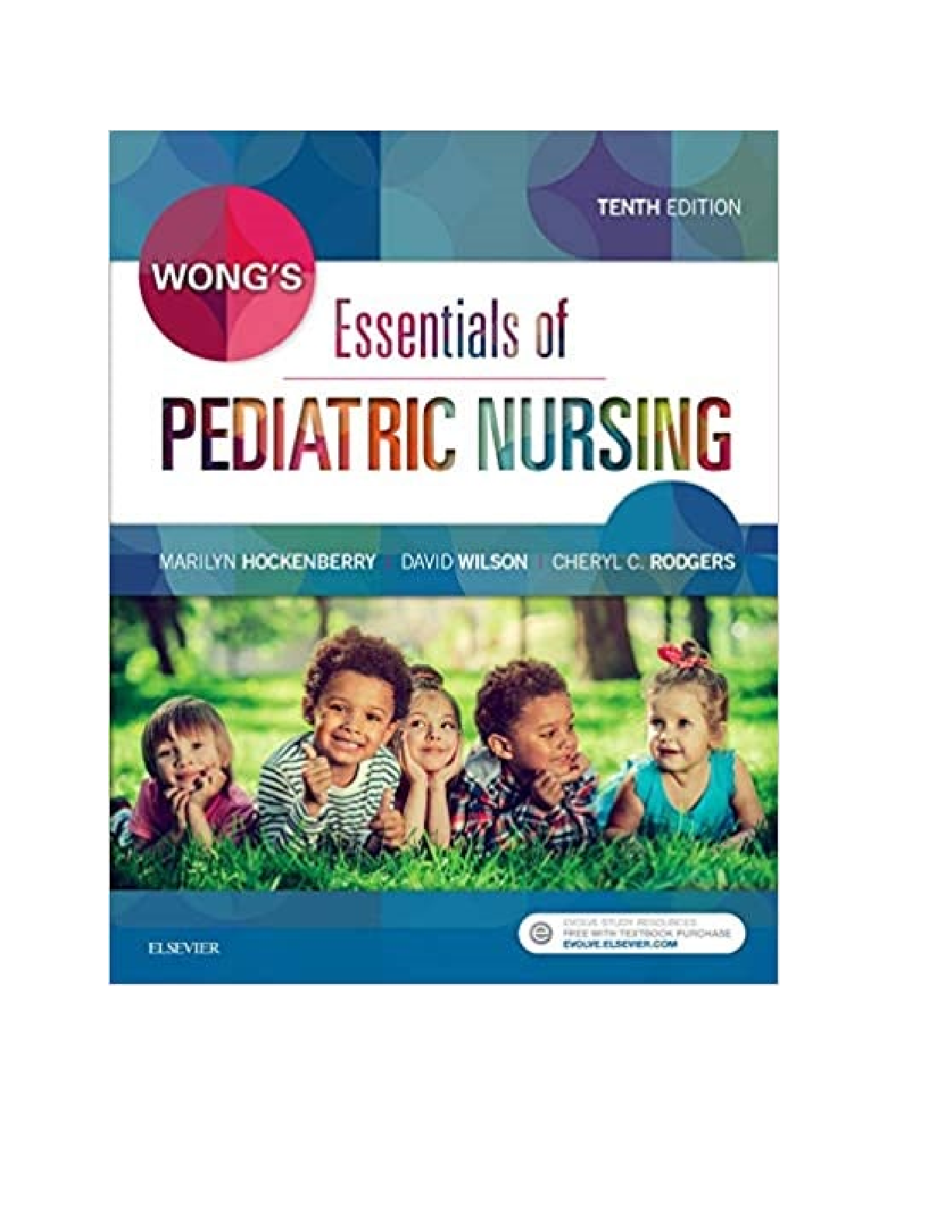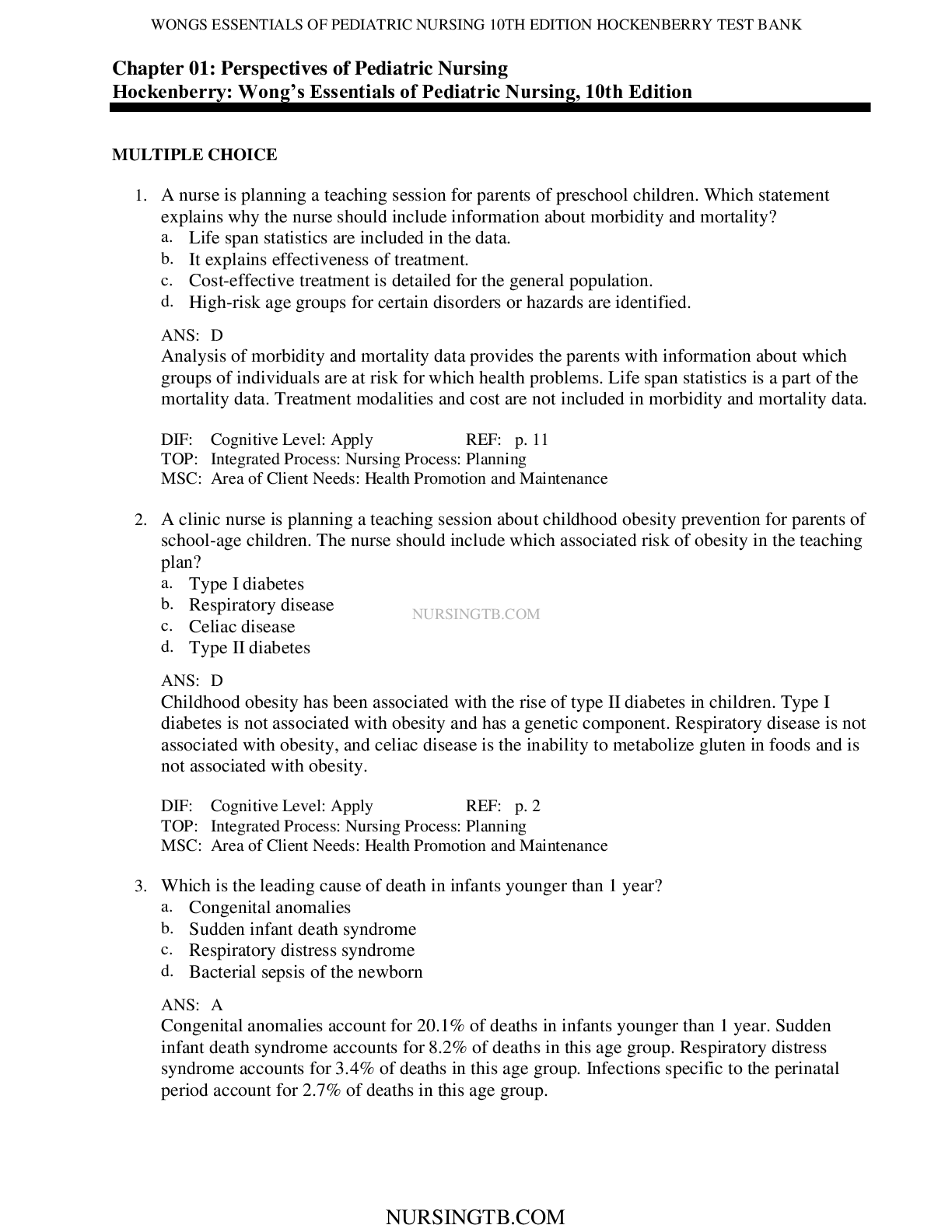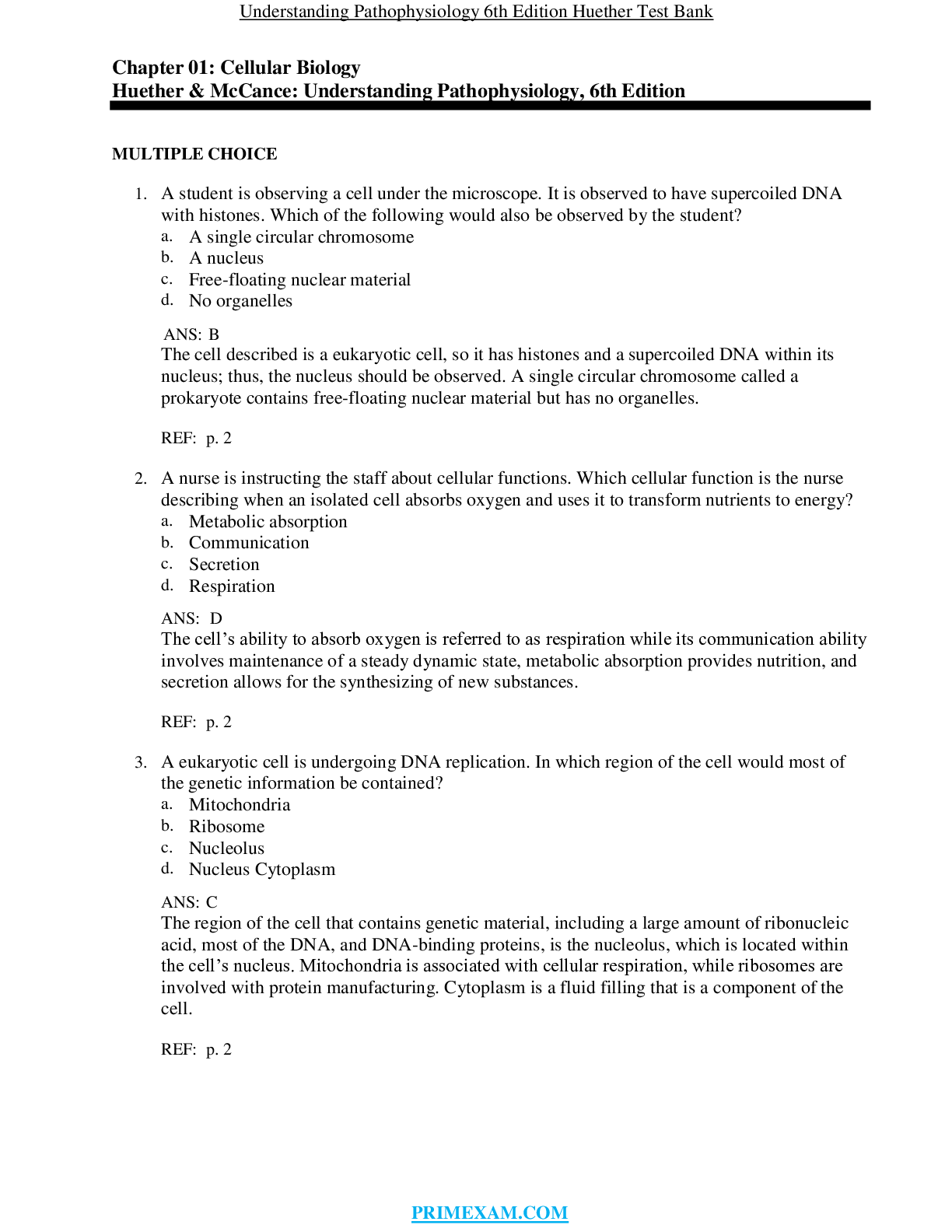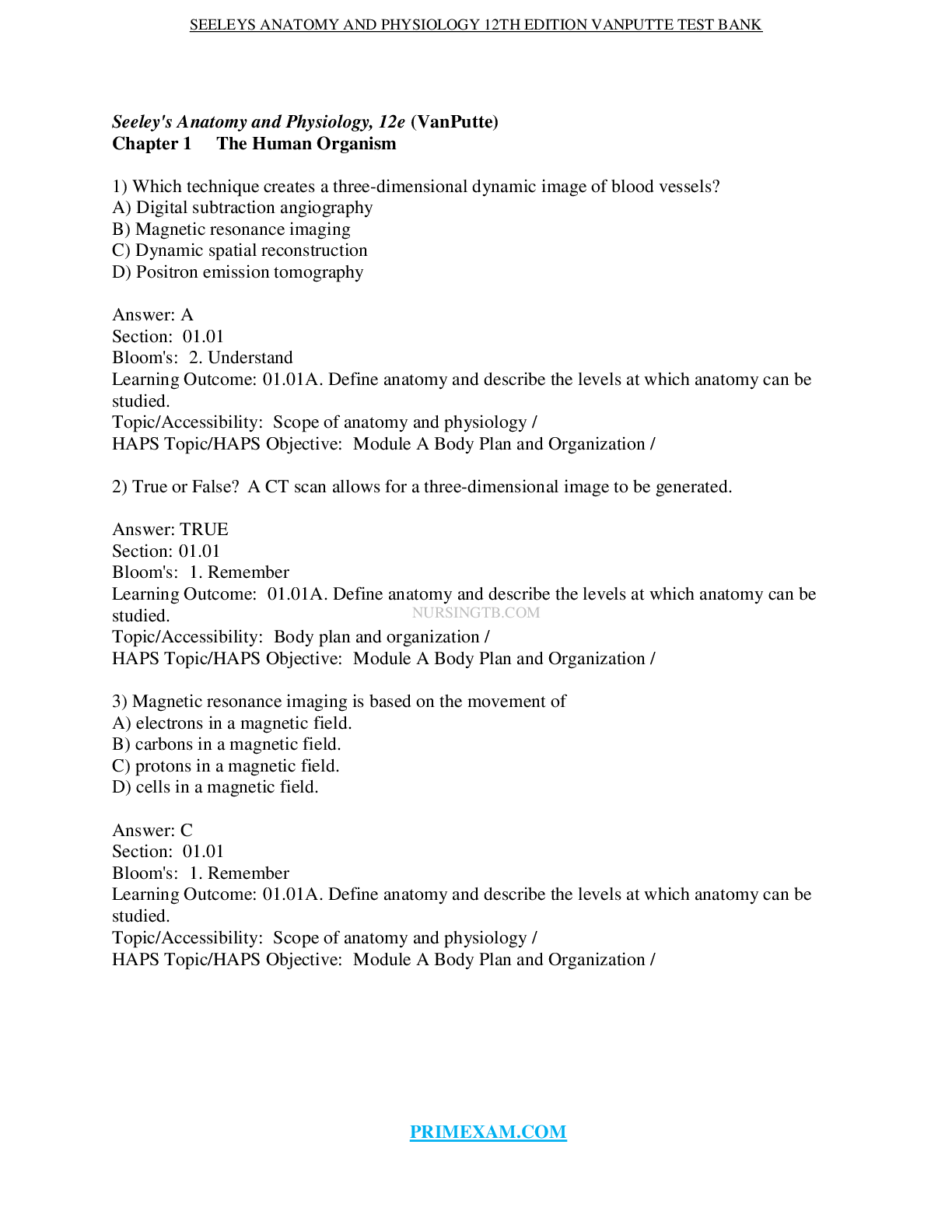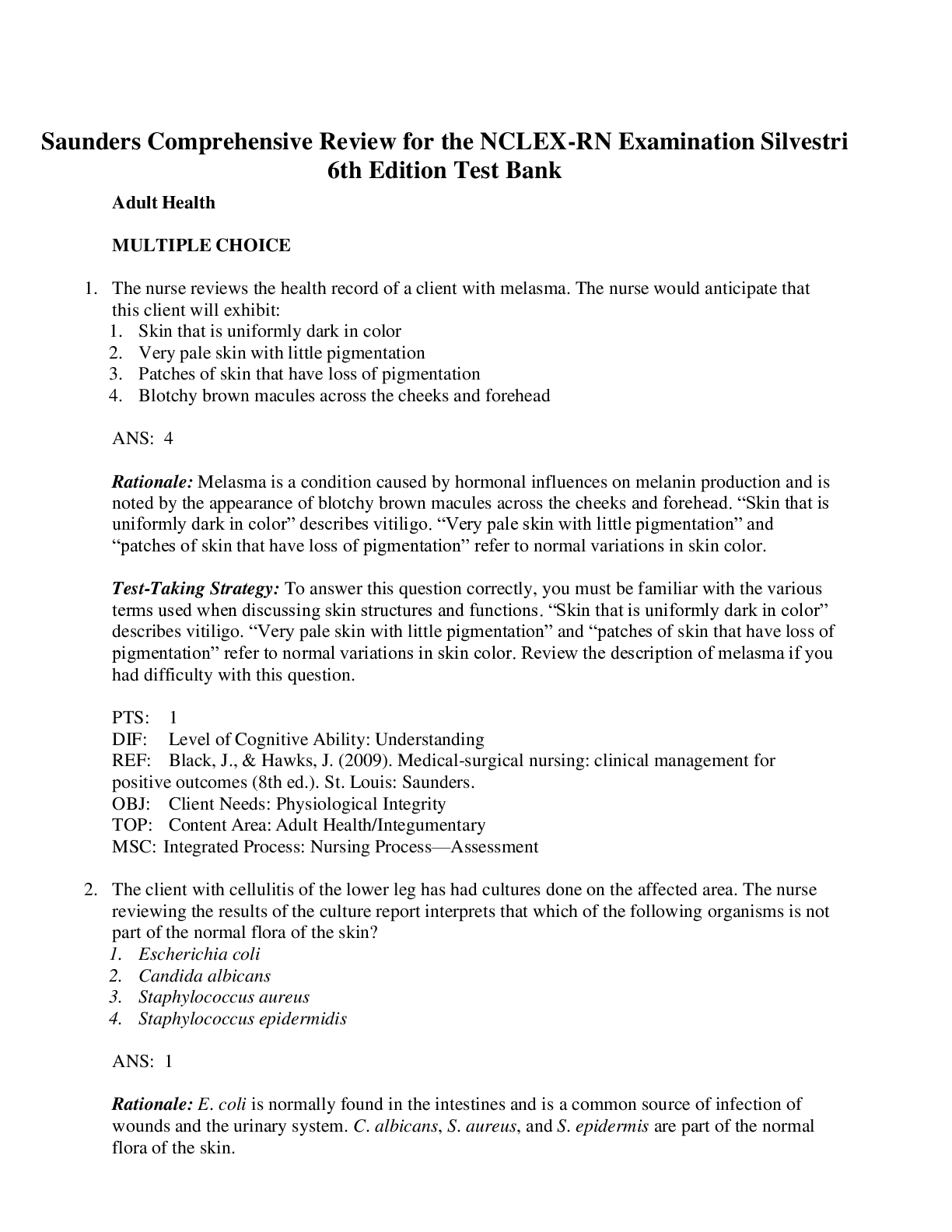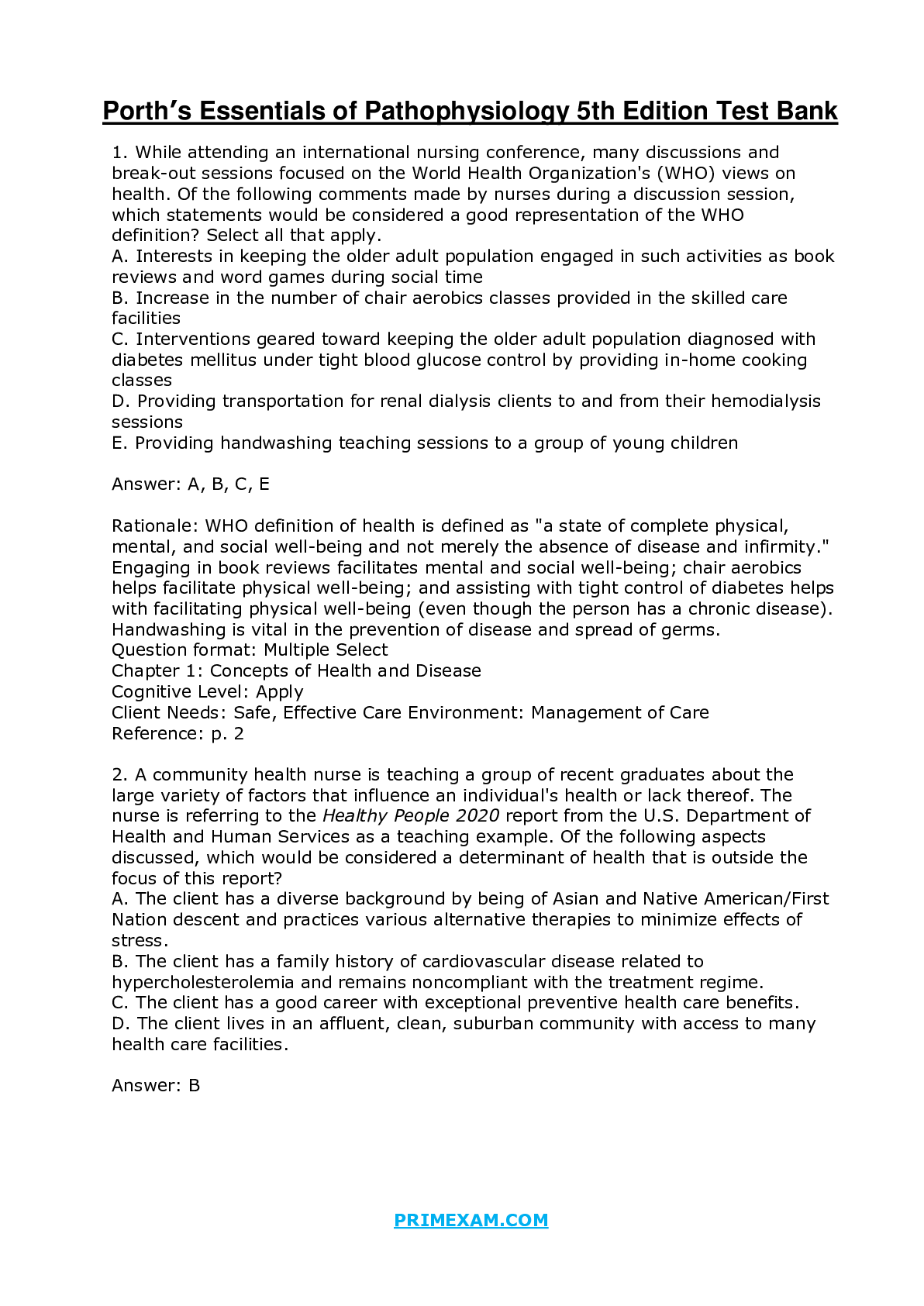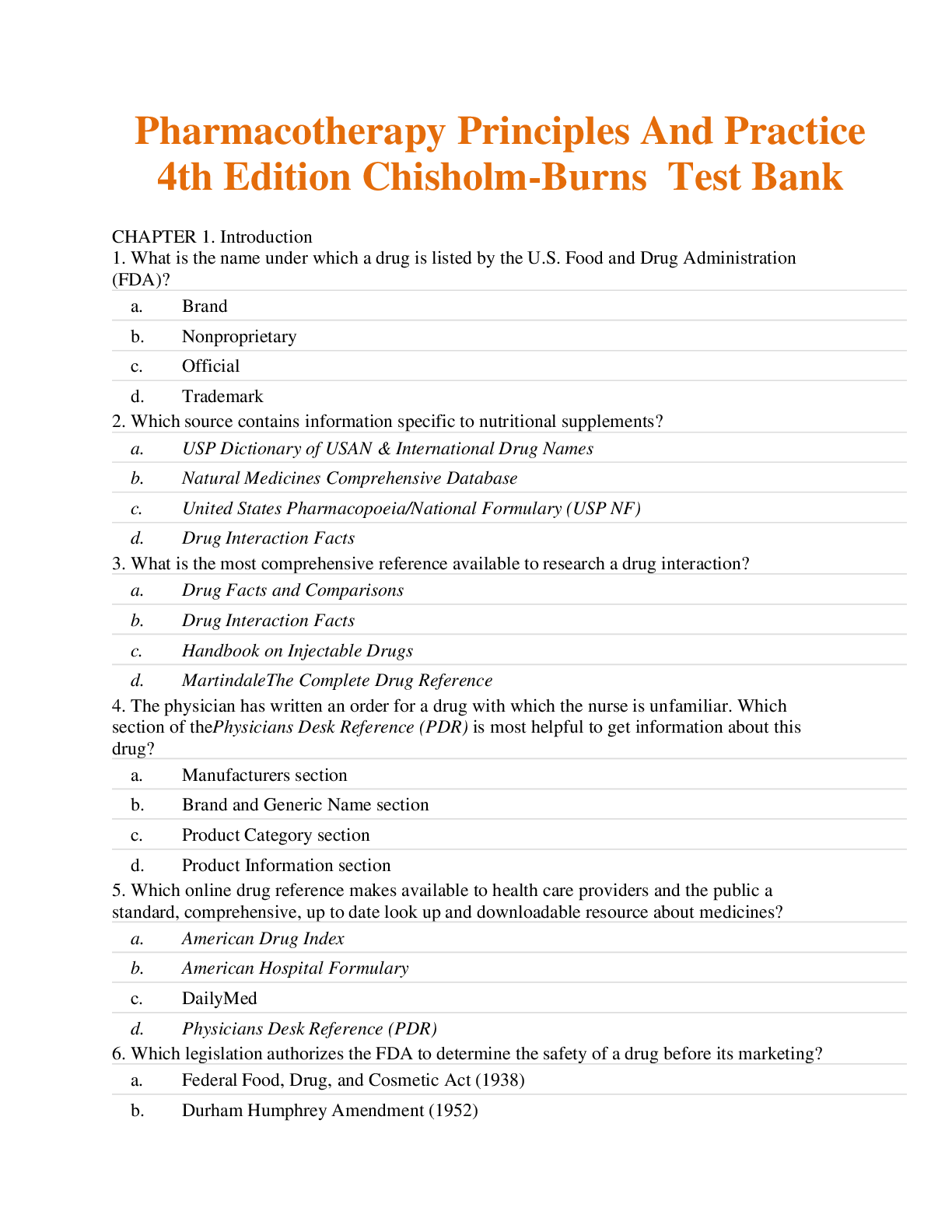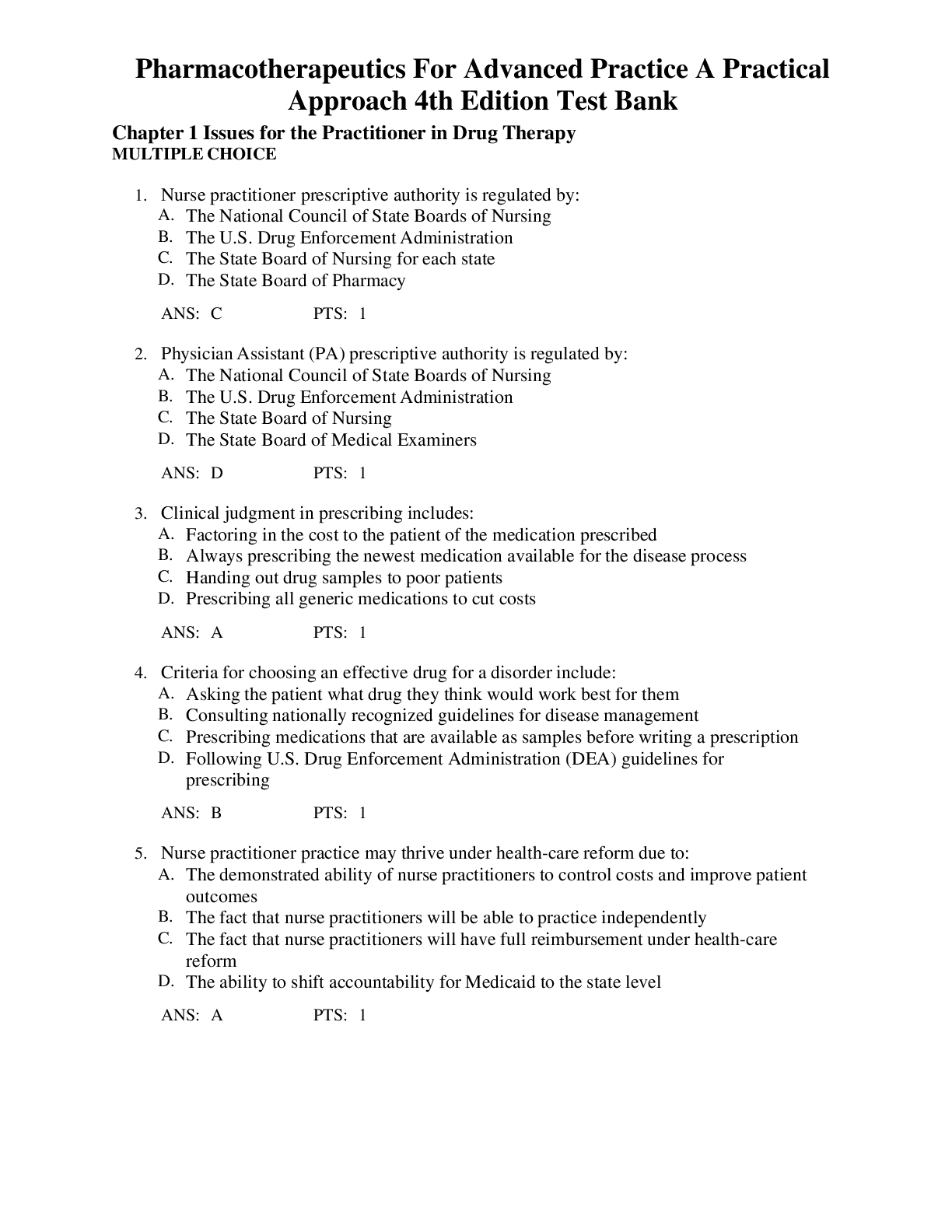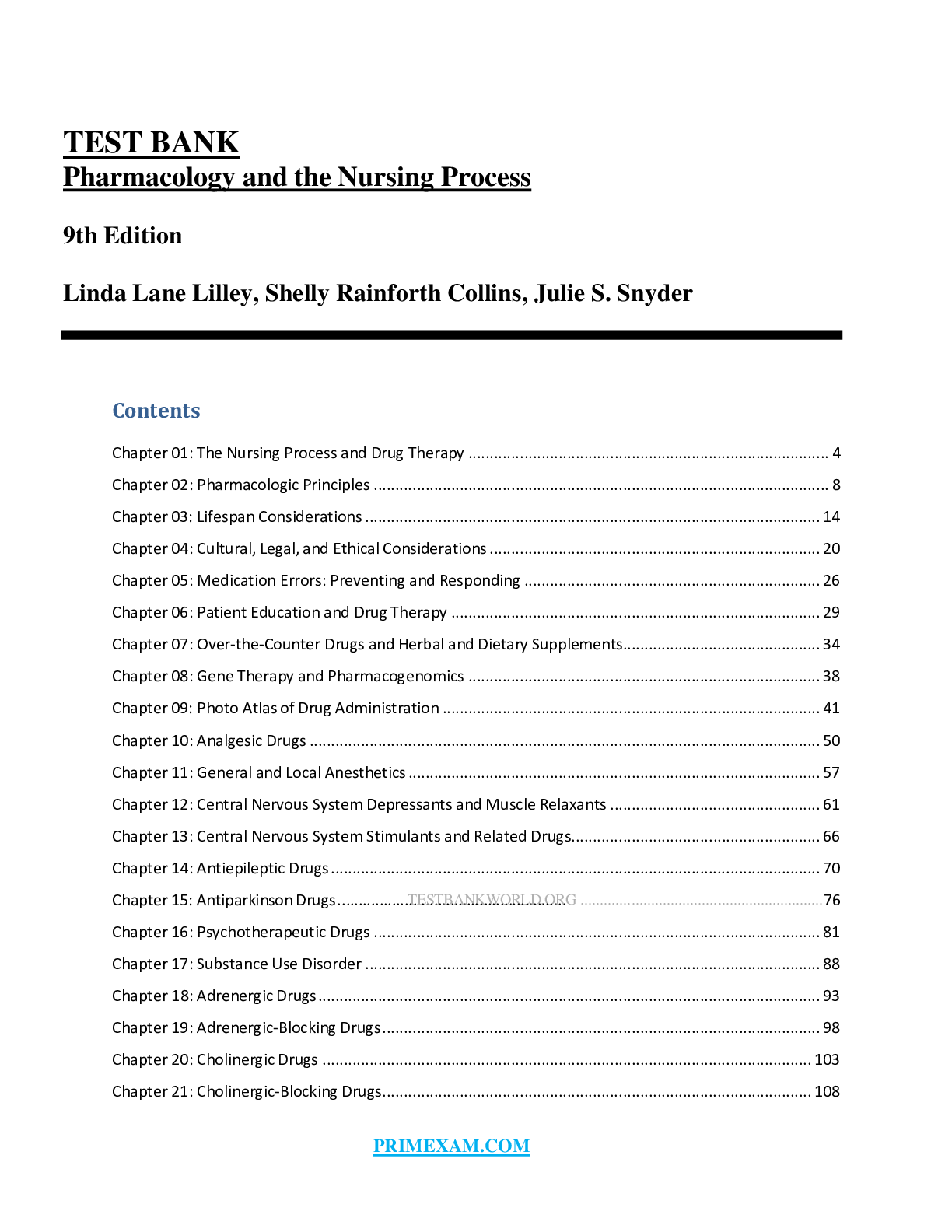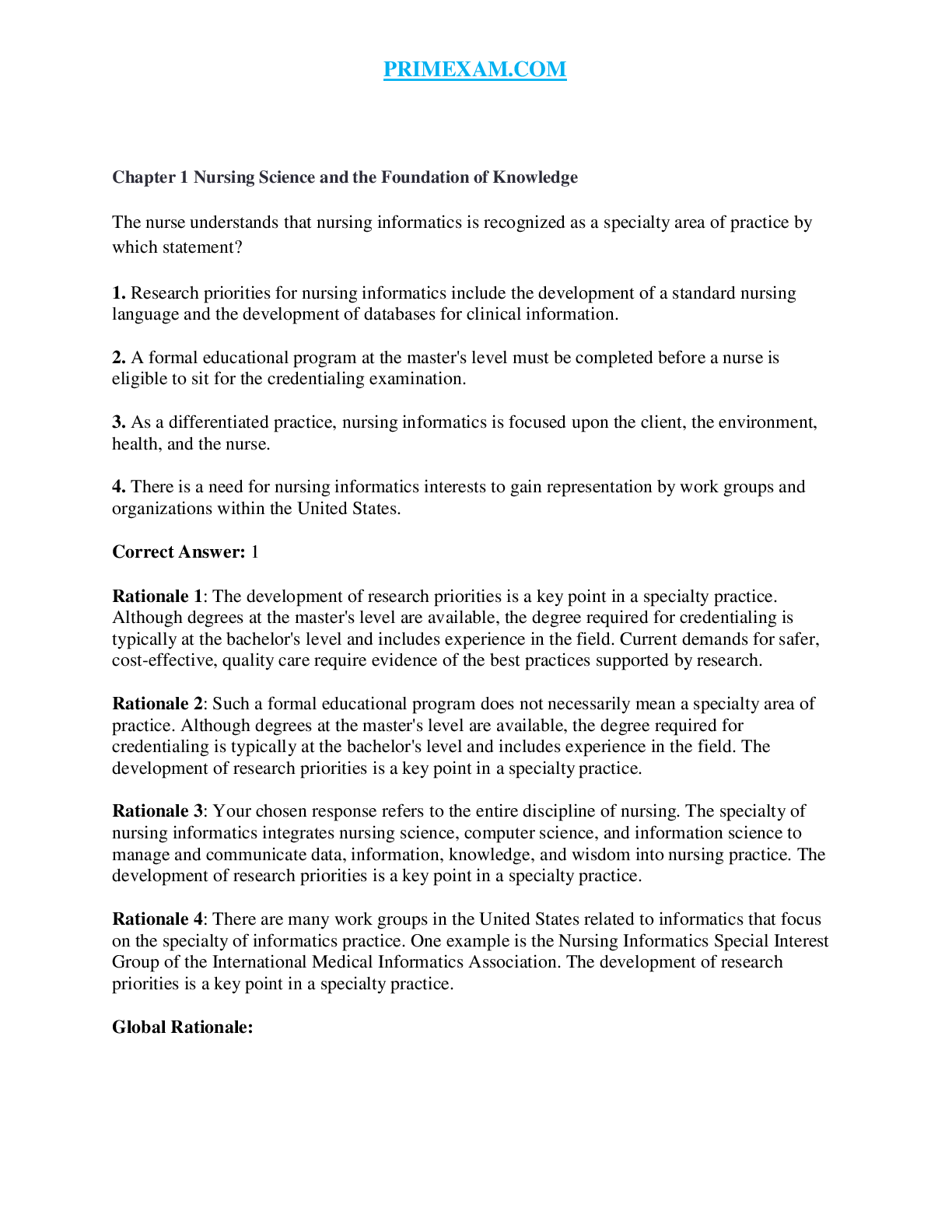*NURSING > TEST BANK > TEST BANK WONG'S ESSENTIALS OF PEDIATRIC NURSING 10TH EDITION Test Bank with Complete Questions and (All)
TEST BANK WONG'S ESSENTIALS OF PEDIATRIC NURSING 10TH EDITION Test Bank with Complete Questions and Solutions 963 PAGES
Document Content and Description Below
TEST BANK WONG'S ESSENTIALS OF PEDIATRIC NURSING 10TH EDITION. Test Bank with Complete Questions and Solutions 963 PAGES. To clarify, this is the test bank, not the textbook. You get immediate access ... to download your test bank. You will receive a complete test bank; in other words, all chapters will be there. Test banks come in PDF format; therefore, you do not need specialized software to open them. PREVIEW..... 1. Question Name: 0001 Type: MC Objective: CH 01: Perspectives of Pediatric Nursing Item Bank: Hockenberry Wong Essentials of Pediatric Nurs 19Ed A nurse is planning a teaching session for parents of preschool children. Which statement explains why the nurse should include information about morbidity and mortality? A. Life-span statistics are included in the data. B. It explains effectiveness of treatment. C. Cost-effective treatment is detailed for the general population. * D. High-risk age groups for certain disorders or hazards are identified. Correct Answer: D Explanation/Rationale: ANS: D Analysis of morbidity and mortality data provides the parents with information about which groups of individuals are at risk for which health problems. Life-span statistics is a part of the mortality data. Treatment modalities and cost are not included in morbidity and mortality data. PTS: 1 DIF: Cognitive Level: Apply REF: 6-8 TOP: Integrated Process: Nursing Process: Planning MSC: Area of Client Needs: Health Promotion and Maintenance Reference/Notes: Keywords: Points: 1.00 Penalty: 0.00 Score Mode: Active Date Created: 03/17/13 17:03:50 Date Modified: 03/17/13 17:03:50 Date Used: Difficulty: Easy Item Analysis: Last No. of Students Responded: 0 Correct Responses (%): Total Group: 0.00 Upper 27% of Group: Lower 27% of Group: Point Biserial: Response Frequencies (%) A Last: Cumulative: 0.00 0.00 B 0.00 0.00 0.00 0.00 0.00 C 0.00 0.00 D 0.00 0.00 ___________________________________________________________________________________________________ 2. Question Name: 0002 Type: MC Objective: CH 01: Perspectives of Pediatric Nursing Item Bank: Hockenberry Wong Essentials of Pediatric Nurs 19Ed A clinic nurse is planning a teaching session about childhood obesity prevention for parents of school-age children. The nurse should include which associated risk of obesity in the teaching plan? Discrimination: Low Item Analysis: Cumulative No. of Students Responded: Correct Responses (%): Total Group: Upper 27% of Group: Lower 27% of Group: Point Biserial: 0 0.00 0.00 0.00 0.00A. Type I diabetes B. Respiratory disease C. Celiac disease * D. Type II diabetes Correct Answer: D Explanation/Rationale: ANS: D Childhood obesity has been associated with the rise of type II diabetes in children. Type I diabetes is not associated with obesity and has a genetic component. Respiratory disease is not associated with obesity, and celiac disease is the inability to metabolize gluten in foods and is not associated with obesity. PTS: 1 DIF: Cognitive Level: Apply REF: 3 TOP: Integrated Process: Nursing Process: Planning MSC: Area of Client Needs: Health Promotion and Maintenance Reference/Notes: Keywords: Points: 1.00 Penalty: 0.00 Score Mode: Active Date Created: 03/17/13 17:03:50 Date Modified: 03/17/13 17:03:50 Date Used: Difficulty: Easy Item Analysis: Last No. of Students Responded: 0 Correct Responses (%): Total Group: 0.00 Upper 27% of Group: Lower 27% of Group: Point Biserial: Response Frequencies (%) A Last: Cumulative: 0.00 0.00 B 0.00 0.00 0.00 0.00 0.00 C 0.00 0.00 D 0.00 0.00 ___________________________________________________________________________________________________ 3. Question Name: 0003 Type: MC Objective: CH 01: Perspectives of Pediatric Nursing Item Bank: Hockenberry Wong Essentials of Pediatric Nurs 19Ed Which is the leading cause of death in infants younger than 1 year? * A. Congenital anomalies B. Sudden infant death syndrome C. Respiratory distress syndrome D. Bacterial sepsis of the newborn Correct Answer: A Explanation/Rationale: ANS: A Congenital anomalies account for 20.1% of deaths in infants younger than 1 year. Sudden Discrimination: Low Item Analysis: Cumulative No. of Students Responded: Correct Responses (%): Total Group: Upper 27% of Group: Lower 27% of Group: Point Biserial: 0 0.00 0.00 0.00 0.00infant death syndrome accounts for 8.2% of deaths in this age group. Respiratory distress syndrome accounts for 3.4% of deaths in this age group. Infections specific to the perinatal period account for 2.7% of deaths in this age group. PTS: 1 DIF: Cognitive Level: Remember REF: 7 TOP: Integrated Process: Nursing Process: Assessment MSC: Area of Client Needs: Health Promotion and Maintenance Reference/Notes: Keywords: Points: 1.00 Penalty: 0.00 Score Mode: Active Date Created: 03/17/13 17:03:50 Date Modified: 03/17/13 17:03:50 Date Used: Difficulty: Easy Item Analysis: Last No. of Students Responded: 0 Correct Responses (%): Total Group: 0.00 Upper 27% of Group: Lower 27% of Group: Point Biserial: Response Frequencies (%) A Last: Cumulative: 0.00 0.00 B 0.00 0.00 0.00 0.00 0.00 C 0.00 0.00 D 0.00 0.00 ___________________________________________________________________________________________________ 4. Question Name: 0004 Type: MC Objective: CH 01: Perspectives of Pediatric Nursing Item Bank: Hockenberry Wong Essentials of Pediatric Nurs 19Ed Which leading cause of death topic should the nurse emphasize to a group of African-American boys ranging in ages 15 to 19 years? A. Suicide B. Cancer * C. Firearm homicide D. Occupational injuries Correct Answer: C Explanation/Rationale: ANS: C Firearm homicide is the second overall cause of death in this age group and the leading cause of death in African-American males. Suicide is the third-leading cause of death in this population. Cancer, although a major health problem, is the fourth-leading cause of death in this age group. Occupational injuries do not contribute to a significant death rate for this age group. PTS: 1 DIF: Cognitive Level: Understand REF: 5 | 8 TOP: Integrated Process: Nursing Process: Planning MSC: Area of Client Needs: Health Promotion and Maintenance Reference/Notes: Discrimination: Low Item Analysis: Cumulative No. of Students Responded: Correct Responses (%): Total Group: Upper 27% of Group: Lower 27% of Group: Point Biserial: 0 0.00 0.00 0.00 0.00Keywords: Points: 1.00 Penalty: 0.00 Score Mode: Active Date Created: 03/17/13 17:03:50 Date Modified: 03/17/13 17:03:50 Date Used: Difficulty: Easy Item Analysis: Last No. of Students Responded: 0 Correct Responses (%): Total Group: 0.00 Upper 27% of Group: Lower 27% of Group: Point Biserial: Response Frequencies (%) A Last: Cumulative: 0.00 0.00 B 0.00 0.00 0.00 0.00 0.00 C 0.00 0.00 D 0.00 0.00 ___________________________________________________________________________________________________ 5. Question Name: 0005 Type: MC Objective: CH 01: Perspectives of Pediatric Nursing Item Bank: Hockenberry Wong Essentials of Pediatric Nurs 19Ed Which is the major cause of death for children older than 1 year? A. Cancer B. Heart disease * C. Unintentional injuries D. Congenital anomalies Correct Answer: C Explanation/Rationale: ANS: C Unintentional injuries (accidents) are the leading cause of death after age 1 year through adolescence. Congenital anomalies are the leading cause of death in those younger than 1 year. Cancer ranks either second or fourth, depending on the age group, and heart disease ranks fifth in the majority of the age groups. PTS: 1 DIF: Cognitive Level: Remember REF: 8 TOP: Integrated Process: Nursing Process: Planning MSC: Area of Client Needs: Health Promotion and Maintenance Reference/Notes: Keywords: Points: 1.00 Penalty: 0.00 Score Mode: Active Date Created: 03/17/13 17:03:50 Date Modified: 03/17/13 17:03:50 Date Used: Difficulty: Easy Item Analysis: Last No. of Students Responded: 0 Correct Responses (%): Total Group: 0.00 Upper 27% of Group: Lower 27% of Group: Point Biserial: 0.00 0.00 0.00 Discrimination: Low Item Analysis: Cumulative No. of Students Responded: Correct Responses (%): Total Group: Upper 27% of Group: Lower 27% of Group: Point Biserial: 0 0.00 0.00 0.00 0.00 Discrimination: Low Item Analysis: Cumulative No. of Students Responded: Correct Responses (%): Total Group: Upper 27% of Group: Lower 27% of Group: Point Biserial: 0 0.00 0.00 0.00 0.00Response Frequencies (%) A Last: Cumulative: 0.00 0.00 B 0.00 0.00 C 0.00 0.00 D 0.00 0.00 ___________________________________________________________________________________________________ 6. Question Name: 0006 Type: MC Objective: CH 01: Perspectives of Pediatric Nursing Item Bank: Hockenberry Wong Essentials of Pediatric Nurs 19Ed Which is the leading cause of death from unintentional injuries for females ranging in age from 1 to 14? A. Mechanical suffocation B. Drowning * C. Motor-vehicle-related fatalities D. Fire- and burn-related fatalities Correct Answer: C Explanation/Rationale: ANS: C Motor-vehicle-related fatalities are the leading cause of death for females ranging in age from 1 to 14, either as passengers or as pedestrians. Mechanical suffocation is fourth or fifth, depending on the age. Drowning is the second- or third-leading cause of death, depending on the age. Fire- and burn-related fatalities are the second-leading cause of death. PTS: 1 DIF: Cognitive Level: Remember REF: 4 TOP: Integrated Process: Nursing Process: Assessment MSC: Area of Client Needs: Health Promotion and Maintenance Reference/Notes: Keywords: Points: 1.00 Penalty: 0.00 Score Mode: Active Date Created: 03/17/13 17:03:50 Date Modified: 03/17/13 17:03:50 Date Used: Difficulty: Easy Item Analysis: Last No. of Students Responded: 0 Correct Responses (%): Total Group: 0.00 Upper 27% of Group: Lower 27% of Group: Point Biserial: Response Frequencies (%) A Last: Cumulative: 0.00 0.00 B 0.00 0.00 0.00 0.00 0.00 C 0.00 0.00 D 0.00 0.00 ___________________________________________________________________________________________________ 7. Question Name: 0007 Type: MC Objective: CH 01: Perspectives of Pediatric Nursing Item Bank: Hockenberry Wong Essentials of Pediatric Nurs 19Ed Discrimination: Low Item Analysis: Cumulative No. of Students Responded: Correct Responses (%): Total Group: Upper 27% of Group: Lower 27% of Group: Point Biserial: 0 0.00 0.00 0.00 0.00Which factor most impacts the type of injury a child is susceptible to, according to the child’s age? A. Physical health of the child * B. Developmental level of the child C. Educational level of the child D. Number of responsible adults in the home Correct Answer: B Explanation/Rationale: ANS: B The child’s developmental stage determines the type of injury that is likely to occur. The child’s physical health may facilitate the child’s recovery from an injury but does not impact the type of injury. Educational level is related to developmental level, but it is not as important as the child’s developmental level in determining the type of injury. The number of responsible adults in the home may affect the number of unintentional injuries, but the type of injury is related to the child’s developmental stage. PTS: 1 DIF: Cognitive Level: Understand REF: 3-4 TOP: Integrated Process: Nursing Process: Planning MSC: Area of Client Needs: Health Promotion and Maintenance Reference/Notes: Keywords: Points: 1.00 Penalty: 0.00 Score Mode: Active Date Created: 03/17/13 17:03:50 Date Modified: 03/17/13 17:03:50 Date Used: Difficulty: Easy Item Analysis: Last No. of Students Responded: 0 Correct Responses (%): Total Group: 0.00 Upper 27% of Group: Lower 27% of Group: Point Biserial: Response Frequencies (%) A Last: Cumulative: 0.00 0.00 B 0.00 0.00 0.00 0.00 0.00 C 0.00 0.00 D 0.00 0.00 ___________________________________________________________________________________________________ 8. Question Name: 0008 Type: MC Objective: CH 01: Perspectives of Pediatric Nursing Item Bank: Hockenberry Wong Essentials of Pediatric Nurs 19Ed Which is now referred to as the “new morbidity”? A. Limitations in the major activities of daily living B. Unintentional injuries that cause chronic health problems C. Discoveries of new therapies to treat health problems * D. Behavioral, social, and educational problems that alter health Correct Answer: D Discrimination: Low Item Analysis: Cumulative No. of Students Responded: Correct Responses (%): Total Group: Upper 27% of Group: Lower 27% of Group: Point Biserial: 0 0.00 0.00 0.00 0.00Explanation/Rationale: ANS: D The new morbidity reflects the behavioral, social, and educational problems that interfere with the child’s social and academic development. It is currently estimated that the incidence of these issues is from 5% to 30%. Limitations in major activities of daily living and unintentional injuries that result in chronic health problems are included in morbidity data. Discovery of new therapies would be reflected in changes in morbidity data over time. PTS: 1 DIF: Cognitive Level: Remember REF: 3 TOP: Integrated Process: Nursing Process: Assessment MSC: Area of Client Needs: Health Promotion and Maintenance Reference/Notes: Keywords: Points: 1.00 Penalty: 0.00 Score Mode: Active Date Created: 03/17/13 17:03:50 Date Modified: 03/17/13 17:03:50 Date Used: Difficulty: Easy Item Analysis: Last No. of Students Responded: 0 Correct Responses (%): Total Group: 0.00 Upper 27% of Group: Lower 27% of Group: Point Biserial: Response Frequencies (%) A Last: Cumulative: 0.00 0.00 B 0.00 0.00 0.00 0.00 0.00 C 0.00 0.00 D 0.00 0.00 ___________________________________________________________________________________________________ 9. Question Name: 0009 Type: MC Objective: CH 01: Perspectives of Pediatric Nursing Item Bank: Hockenberry Wong Essentials of Pediatric Nurs 19Ed A nurse on a pediatric unit is practicing family-centered care. Which is most descriptive of the care the nurse is delivering? A. Taking over total care of the child to reduce stress on the family B. Encouraging family dependence on health care systems * C. Recognizing that the family is the constant in a child’s life D. Excluding families from the decision-making process Correct Answer: C Explanation/Rationale: ANS: C The three key components of family-centered care are respect, collaboration, and support. Family-centered care recognizes the family as the constant in the child’s life. Taking over total care does not include the family in the process and may increase stress instead of reducing stress. The family should be enabled and empowered to work with the health care system. The family is expected to be part of the decision-making process. Discrimination: Low Item Analysis: Cumulative No. of Students Responded: Correct Responses (%): Total Group: Upper 27% of Group: Lower 27% of Group: Point Biserial: 0 0.00 0.00 0.00 0.00PTS: 1 DIF: Cognitive Level: Remember REF: 8 TOP: Integrated Process: Nursing Process: Implementation MSC: Area of Client Needs: Health Promotion and Maintenance Reference/Notes: Keywords: Points: 1.00 Penalty: 0.00 Score Mode: Active Date Created: 03/17/13 17:03:50 Date Modified: 03/17/13 17:03:50 Date Used: Difficulty: Easy Item Analysis: Last No. of Students Responded: 0 Correct Responses (%): Total Group: 0.00 Upper 27% of Group: Lower 27% of Group: Point Biserial: Response Frequencies (%) A Last: Cumulative: 0.00 0.00 B 0.00 0.00 0.00 0.00 0.00 C 0.00 0.00 D 0.00 0.00 ___________________________________________________________________________________________________ 10. Question Name: 0010 Type: MC Objective: CH 01: Perspectives of Pediatric Nursing Item Bank: Hockenberry Wong Essentials of Pediatric Nurs 19Ed The nurse is preparing an in-service education to staff about atraumatic care for pediatric patients. Which intervention should the nurse include? A. Prepare the child for separation from parents during hospitalization by reviewing a video. * B. Prepare the child before any unfamiliar treatment or procedure by demonstrating on a stuffed animal. C. Help the child accept the loss of control associated with hospitalization. D. Help the child accept pain that is connected with a treatment or procedure. Correct Answer: B Explanation/Rationale: ANS: B Preparing the child for any unfamiliar treatments, controlling pain, allowing privacy, providing play activities for expression of fear and aggression, providing choices, and respecting cultural differences are components of atraumatic care. In the provision of atraumatic care, the separation of child from parents during hospitalization is minimized. The nurse should promote a sense of control for the child. Preventing and minimizing bodily injury and pain are major components of atraumatic care. PTS: 1 DIF: Cognitive Level: Understand REF: 9 TOP: Integrated Process: Nursing Process: Implementation MSC: Area of Client Needs: Psychosocial Integrity Reference/Notes: Discrimination: Low Item Analysis: Cumulative No. of Students Responded: Correct Responses (%): Total Group: Upper 27% of Group: Lower 27% of Group: Point Biserial: 0 0.00 0.00 0.00 0.00Keywords: Points: 1.00 Penalty: 0.00 Score Mode: Active Date Created: 03/17/13 17:03:50 Date Modified: 03/17/13 17:03:50 Date Used: Difficulty: Easy Item Analysis: Last No. of Students Responded: 0 Correct Responses (%): Total Group: 0.00 Upper 27% of Group: Lower 27% of Group: Point Biserial: Response Frequencies (%) A Last: Cumulative: 0.00 0.00 B 0.00 0.00 0.00 0.00 0.00 C 0.00 0.00 D 0.00 0.00 ___________________________________________________________________________________________________ 11. Question Name: 0011 Type: MC Objective: CH 01: Perspectives of Pediatric Nursing Item Bank: Hockenberry Wong Essentials of Pediatric Nurs 19Ed Which is most suggestive that a nurse has a nontherapeutic relationship with a patient and family? * A. Staff is concerned about the nurse’s actions with the patient and family. B. Staff assignments allow the nurse to care for same patient and family over an extended time. C. Nurse is able to withdraw emotionally when emotional overload occurs but still remains committed. D. Nurse uses teaching skills to instruct patient and family rather than doing everything for them. Correct Answer: A Explanation/Rationale: ANS: A An important clue to a nontherapeutic staff-patient relationship is concern of other staff members. Allowing the nurse to care for the same patient over time would be therapeutic for the patient and family. Nurses who are able to somewhat withdraw emotionally can protect themselves while providing therapeutic care. Nurses using teaching skills to instruct patient and family will assist in transitioning the child and family to self-care. PTS: 1 DIF: Cognitive Level: Analyze REF: 9 TOP: Integrated Process: Nursing Process: Assessment MSC: Area of Client Needs: Psychosocial Integrity Reference/Notes: Keywords: Points: 1.00 Penalty: 0.00 Score Mode: Active Date Created: 03/17/13 17:03:50 Date Modified: 03/17/13 17:03:50 Date Used: Difficulty: Easy Item Analysis: Last No. of Students Responded: 0 Correct Responses (%): Discrimination: Low Item Analysis: Cumulative No. of Students Responded: Correct Responses (%): 0 Discrimination: Low Item Analysis: Cumulative No. of Students Responded: Correct Responses (%): Total Group: Upper 27% of Group: Lower 27% of Group: Point Biserial: 0 0.00 0.00 0.00 0.00Total Group: Upper 27% of Group: Lower 27% of Group: Point Biserial: Response Frequencies (%) A Last: Cumulative: 0.00 0.00 B 0.00 0.00 0.00 0.00 0.00 0.00 C 0.00 0.00 D 0.00 0.00 ___________________________________________________________________________________________________ 12. Question Name: 0012 Type: MC Objective: CH 01: Perspectives of Pediatric Nursing Item Bank: Hockenberry Wong Essentials of Pediatric Nurs 19Ed Which is most descriptive of clinical reasoning? A. A simple developmental process * B. Purposeful and goal-directed C. Based on deliberate and irrational thought D. Assists individuals in guessing what is most appropriate Correct Answer: B Explanation/Rationale: ANS: B Clinical reasoning is a complex, developmental process based on rational and deliberate thought. Clinical reasoning is not a developmental process. Clinical reasoning is based on rational and deliberate thought. Clinical reasoning is not a guessing process. PTS: 1 DIF: Cognitive Level: Understand REF: 12 TOP: Integrated Process: Nursing Process: Planning MSC: Area of Client Needs: Safe and Effective Care Environment: Management of Care Reference/Notes: Keywords: Points: 1.00 Penalty: 0.00 Score Mode: Active Date Created: 03/17/13 17:03:50 Date Modified: 03/17/13 17:03:50 Date Used: Difficulty: Easy Item Analysis: Last No. of Students Responded: 0 Correct Responses (%): Total Group: 0.00 Upper 27% of Group: Lower 27% of Group: Point Biserial: Response Frequencies (%) A Last: Cumulative: 0.00 0.00 B 0.00 0.00 0.00 0.00 0.00 C 0.00 0.00 D 0.00 0.00 ___________________________________________________________________________________________________ 13. Question Name: 0013 Type: MC Objective: CH 01: Perspectives of Pediatric Nursing Item Bank: Discrimination: Low Item Analysis: Cumulative No. of Students Responded: Correct Responses (%): Total Group: Upper 27% of Group: Lower 27% of Group: Point Biserial: 0 0.00 0.00 0.00 0.00 Total Group: Upper 27% of Group: Lower 27% of Group: Point Biserial: 0.00 0.00 0.00 0.00Hockenberry Wong Essentials of Pediatric Nurs 19Ed A nurse makes the decision to apply a topical anesthetic to a child’s skin before drawing blood. Which ethical principle is the nurse demonstrating? A. Autonomy * B. Beneficence C. Justice D. Truthfulness Correct Answer: B Explanation/Rationale: ANS: B Beneficence is the obligation to promote the patient’s well-being. Applying a topical anesthetic before drawing blood promotes reducing the discomfort of the venipuncture. Autonomy is the patient’s right to be self-governing. Justice is the concept of fairness. Truthfulness is the concept of honesty. PTS: 1 DIF: Cognitive Level: Understand REF: 11 TOP: Integrated Process: Nursing Process: Implementation MSC: Area of Client Needs: Physiological Integrity Reference/Notes: Keywords: Points: 1.00 Penalty: 0.00 Score Mode: Active Date Created: 03/17/13 17:03:50 Date Modified: 03/17/13 17:03:50 Date Used: Difficulty: Easy Item Analysis: Last No. of Students Responded: 0 Correct Responses (%): Total Group: 0.00 Upper 27% of Group: Lower 27% of Group: Point Biserial: Response Frequencies (%) A Last: Cumulative: 0.00 0.00 B 0.00 0.00 0.00 0.00 0.00 C 0.00 0.00 D 0.00 0.00 ___________________________________________________________________________________________________ 14. Question Name: 0014 Type: MC Objective: CH 01: Perspectives of Pediatric Nursing Item Bank: Hockenberry Wong Essentials of Pediatric Nurs 19Ed Which action by the nurse demonstrates use of evidence-based practice (EBP)? A. Gathering equipment for a procedure B. Documenting changes in a patient’s status * C. Questioning the use of daily central line dressing changes D. Clarifying a physician’s prescription for morphine Correct Answer: C Explanation/Rationale: Discrimination: Low Item Analysis: Cumulative No. of Students Responded: Correct Responses (%): Total Group: Upper 27% of Group: Lower 27% of Group: Point Biserial: 0 0.00 0.00 0.00 0.00ANS: C The nurse who questions the daily central line dressing change is ascertaining whether clinical interventions result in positive outcomes for patients. This demonstrates evidence-based practice (EBP), which implies questioning why something is effective and whether a better approach exists. Gathering equipment for a procedure and documenting changes in a patient’s status are practices that follow established guidelines. Clarifying a physician’s prescription for morphine constitutes safe nursing care. PTS: 1 DIF: Cognitive Level: Apply REF: 11 TOP: Integrated Process: Nursing Process: Evaluation MSC: Area of Client Needs: Safe and Effective Care Environment: Management of Care Reference/Notes: Keywords: Points: 1.00 Penalty: 0.00 Score Mode: Active Date Created: 03/17/13 17:03:50 Date Modified: 03/17/13 17:03:50 Date Used: Difficulty: Easy Item Analysis: Last No. of Students Responded: 0 Correct Responses (%): Total Group: 0.00 Upper 27% of Group: Lower 27% of Group: Point Biserial: Response Frequencies (%) A Last: Cumulative: 0.00 0.00 B 0.00 0.00 0.00 0.00 0.00 C 0.00 0.00 D 0.00 0.00 ___________________________________________________________________________________________________ 15. Question Name: 0015 Type: MC Objective: CH 01: Perspectives of Pediatric Nursing Item Bank: Hockenberry Wong Essentials of Pediatric Nurs 19Ed A nurse is admitting a toddler to the hospital. The toddler is with both parents and is currently sitting comfortably on a parent’s lap. The parents state they will need to leave for a brief period. Which type of nursing diagnosis should the nurse formulate for this child? * A. Risk for anxiety B. Anxiety C. Readiness for enhanced coping D. Ineffective coping Correct Answer: A Explanation/Rationale: ANS: A A potential problem is categorized as a risk. The toddler has a risk to become anxious when the parents leave. Nursing interventions will be geared toward reducing the risk. The child is not showing current anxiety or ineffective coping. The child is not at a point for readiness for enhanced coping, especially because the parents will be leaving. Discrimination: Low Item Analysis: Cumulative No. of Students Responded: Correct Responses (%): Total Group: Upper 27% of Group: Lower 27% of Group: Point Biserial: 0 0.00 0.00 0.00 0.00PTS: 1 DIF: Cognitive Level: Remember REF: 12 TOP: Integrated Process: Nursing Process: Diagnosis MSC: Area of Client Needs: Health Promotion and Maintenance Reference/Notes: Keywords: Points: 1.00 Penalty: 0.00 Score Mode: Active Date Created: 03/17/13 17:03:50 Date Modified: 03/17/13 17:03:50 Date Used: Difficulty: Easy Item Analysis: Last No. of Students Responded: 0 Correct Responses (%): Total Group: 0.00 Upper 27% of Group: Lower 27% of Group: Point Biserial: Response Frequencies (%) A Last: Cumulative: 0.00 0.00 B 0.00 0.00 0.00 0.00 0.00 C 0.00 0.00 D 0.00 0.00 ___________________________________________________________________________________________________ 16. Question Name: 0016 Type: MC Objective: CH 01: Perspectives of Pediatric Nursing Item Bank: Hockenberry Wong Essentials of Pediatric Nurs 19Ed A child has a postoperative appendectomy incision covered by a dressing. The nurse has just completed a prescribed dressing change for this child. Which description is an accurate documentation of this procedure? A. Dressing change to appendectomy incision completed, child tolerated procedure well, parent present B. No complications noted during dressing change to appendectomy incision * C. Appendectomy incision non-reddened, sutures intact, no drainage noted on old dressing, new dressing applied, procedure tolerated well by child D. No changes to appendectomy incisional area, dressing changed, child complained of pain during procedure, new dressing clean, dry and intact Correct Answer: C Explanation/Rationale: ANS: C The nurse should document assessments and reassessments. Appearance of the incision described in objective terms should be included during a dressing change. The nurse should document patient’s response and the outcomes of the care provided. In this example, these include drainage on the old dressing, the application of the new dressing, and the child’s response. The other statements partially fulfill the requirements of documenting assessments and reassessments, patient’s response, and outcome, but do not include all three. PTS: 1 DIF: Cognitive Level: Analyze REF: 14 TOP: Integrated Process: Nursing Process: Implementation MSC: Area of Client Needs: Safe and Effective Care Environment: Management of Care Discrimination: Low Item Analysis: Cumulative No. of Students Responded: Correct Responses (%): Total Group: Upper 27% of Group: Lower 27% of Group: Point Biserial: [Show More]
Last updated: 1 year ago
Preview 1 out of 963 pages
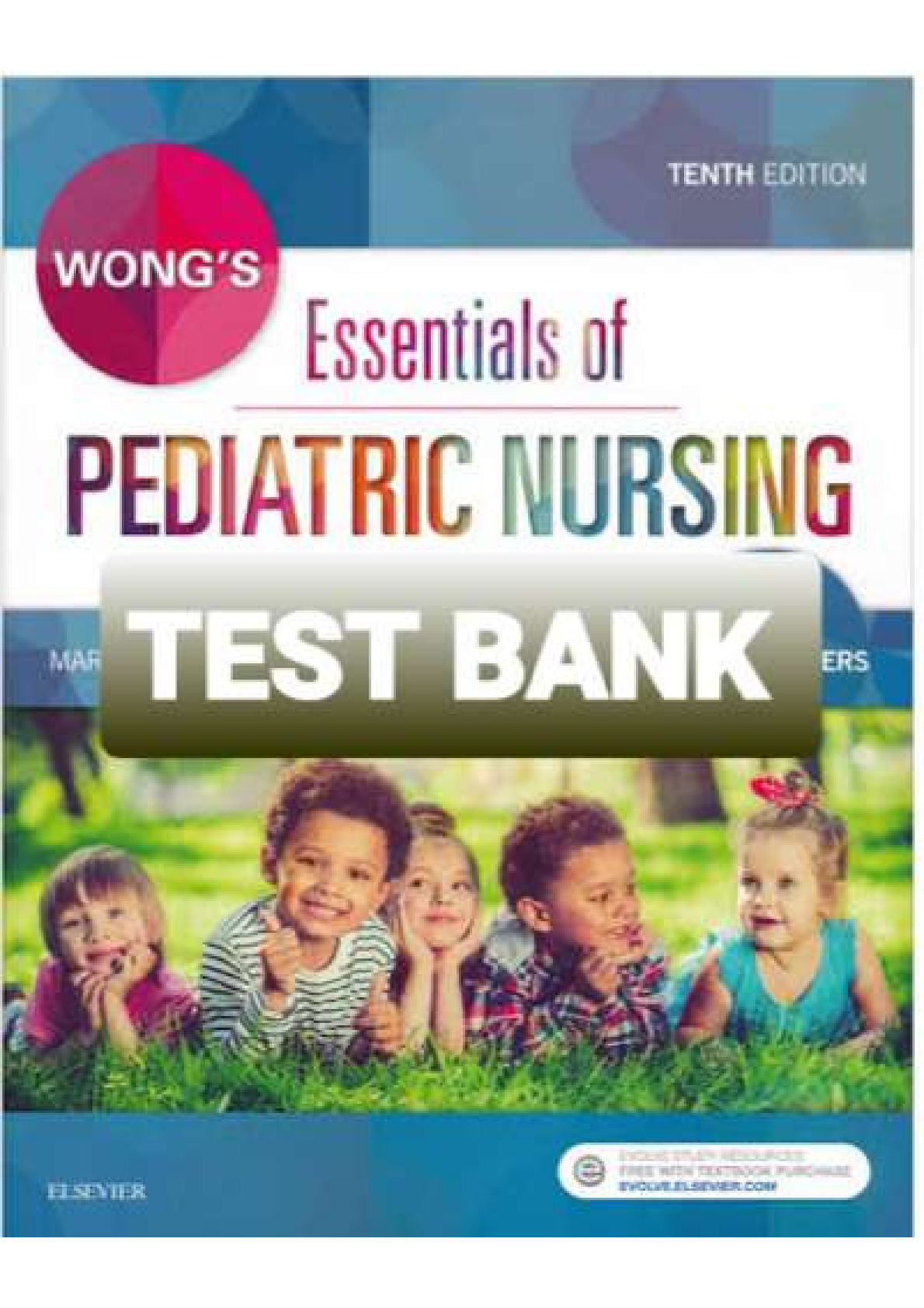
Reviews( 0 )
Document information
Connected school, study & course
About the document
Uploaded On
Oct 12, 2021
Number of pages
963
Written in
Additional information
This document has been written for:
Uploaded
Oct 12, 2021
Downloads
0
Views
141

